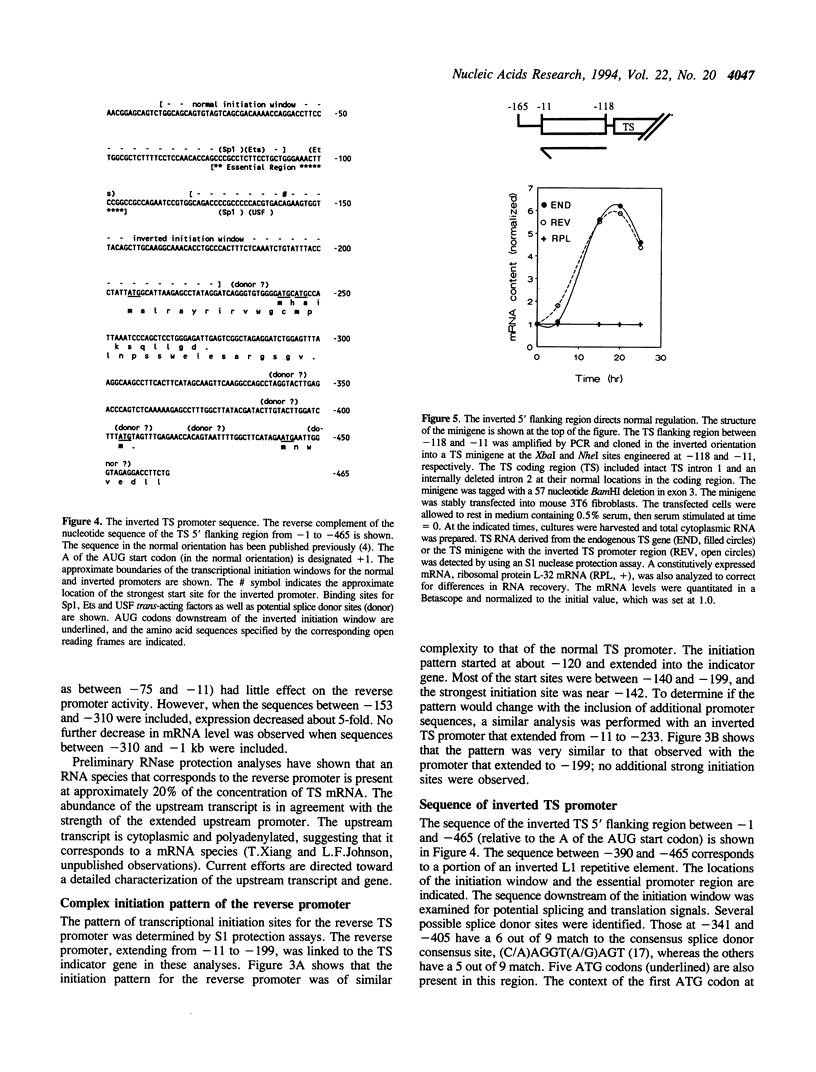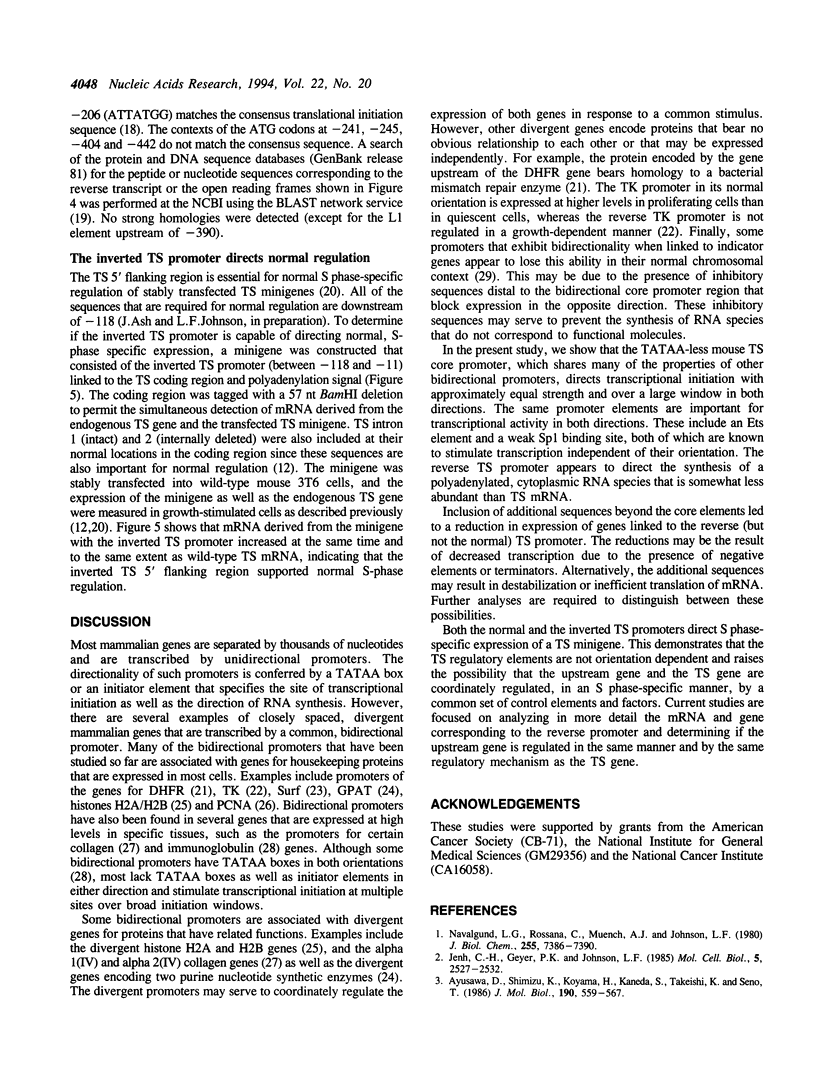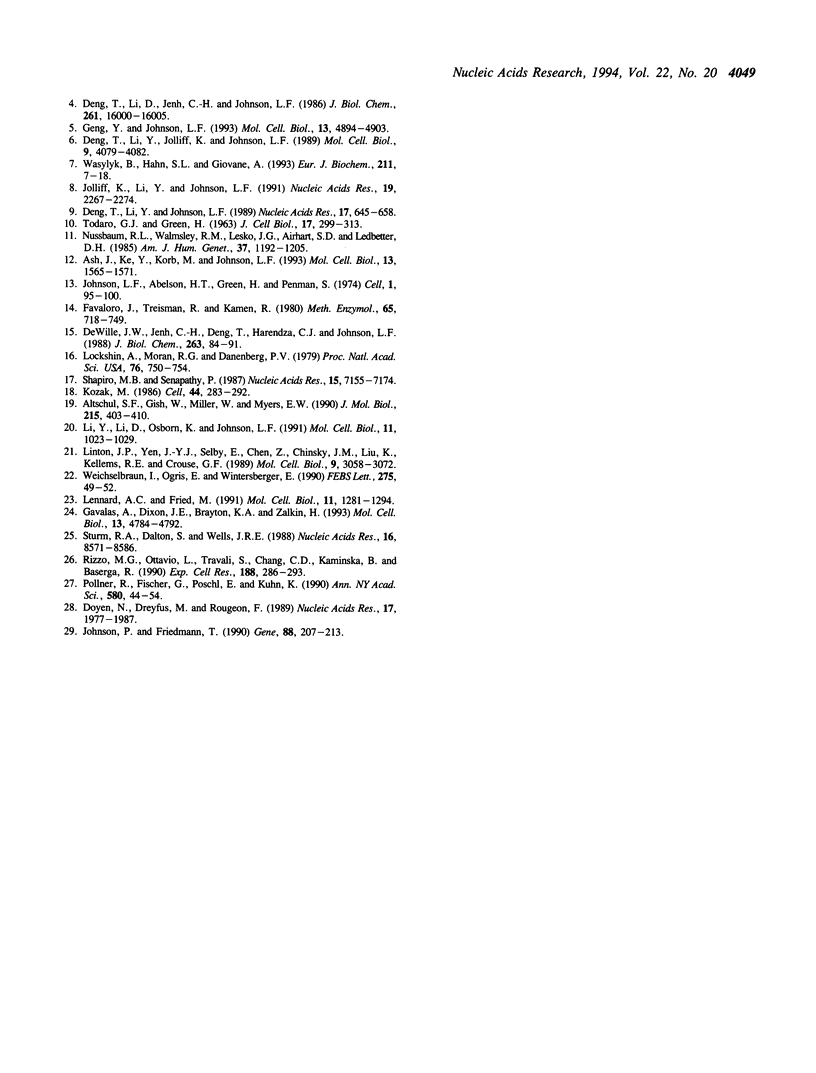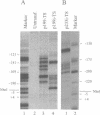Abstract
The promoter of the mouse thymidylate synthase (TS) gene lacks both a TATAA box and an initiator element and directs transcriptional initiation at multiple sites over a 90 nucleotide initiation window. Earlier studies defined an essential region near the 5' end of the initiation window that is required for promoter activity. The essential region contains possible binding sites for Sp1 and Ets transcription factors. In the present study we show that this essential region stimulates transcription with approximately equal strength in both directions. Transcription is initiated over a broad initiation window in the reverse direction. The same elements are important for the reverse promoter and for the normal TS promoter. Sequences upstream of the essential region partially suppress expression in the reverse direction. The TS 5' flanking region, in either the normal or inverted orientation, directs S phase-specific expression of a TS minigene. This raises the possibility that an upstream gene and the TS gene may be coordinately induced at the G1/S phase boundary by a common set of control elements.
Full text
PDF





Images in this article
Selected References
These references are in PubMed. This may not be the complete list of references from this article.
- Altschul S. F., Gish W., Miller W., Myers E. W., Lipman D. J. Basic local alignment search tool. J Mol Biol. 1990 Oct 5;215(3):403–410. doi: 10.1016/S0022-2836(05)80360-2. [DOI] [PubMed] [Google Scholar]
- Ash J., Ke Y., Korb M., Johnson L. F. Introns are essential for growth-regulated expression of the mouse thymidylate synthase gene. Mol Cell Biol. 1993 Mar;13(3):1565–1571. doi: 10.1128/mcb.13.3.1565. [DOI] [PMC free article] [PubMed] [Google Scholar]
- Ayusawa D., Shimizu K., Koyama H., Kaneda S., Takeishi K., Seno T. Cell-cycle-directed regulation of thymidylate synthase messenger RNA in human diploid fibroblasts stimulated to proliferate. J Mol Biol. 1986 Aug 20;190(4):559–567. doi: 10.1016/0022-2836(86)90241-x. [DOI] [PubMed] [Google Scholar]
- DeWille J. W., Jenh C. H., Deng T., Harendza C. J., Johnson L. F. Construction and expression of mouse thymidylate synthase minigenes. J Biol Chem. 1988 Jan 5;263(1):84–91. [PubMed] [Google Scholar]
- Deng T. L., Li D. W., Jenh C. H., Johnson L. F. Structure of the gene for mouse thymidylate synthase. Locations of introns and multiple transcriptional start sites. J Biol Chem. 1986 Dec 5;261(34):16000–16005. [PubMed] [Google Scholar]
- Deng T. L., Li Y., Johnson L. F. Thymidylate synthase gene expression is stimulated by some (but not all) introns. Nucleic Acids Res. 1989 Jan 25;17(2):645–658. doi: 10.1093/nar/17.2.645. [DOI] [PMC free article] [PubMed] [Google Scholar]
- Deng T., Li Y., Jolliff K., Johnson L. F. The mouse thymidylate synthase promoter: essential elements are in close proximity to the transcriptional initiation sites. Mol Cell Biol. 1989 Sep;9(9):4079–4082. doi: 10.1128/mcb.9.9.4079. [DOI] [PMC free article] [PubMed] [Google Scholar]
- Doyen N., Dreyfus M., Rougeon F. Regulatory elements involved in the bidirectional activity of an immunoglobulin promoter. Nucleic Acids Res. 1989 Mar 11;17(5):1977–1987. doi: 10.1093/nar/17.5.1977. [DOI] [PMC free article] [PubMed] [Google Scholar]
- Favaloro J., Treisman R., Kamen R. Transcription maps of polyoma virus-specific RNA: analysis by two-dimensional nuclease S1 gel mapping. Methods Enzymol. 1980;65(1):718–749. doi: 10.1016/s0076-6879(80)65070-8. [DOI] [PubMed] [Google Scholar]
- Gavalas A., Dixon J. E., Brayton K. A., Zalkin H. Coexpression of two closely linked avian genes for purine nucleotide synthesis from a bidirectional promoter. Mol Cell Biol. 1993 Aug;13(8):4784–4792. doi: 10.1128/mcb.13.8.4784. [DOI] [PMC free article] [PubMed] [Google Scholar]
- Geng Y., Johnson L. F. Lack of an initiator element is responsible for multiple transcriptional initiation sites of the TATA-less mouse thymidylate synthase promoter. Mol Cell Biol. 1993 Aug;13(8):4894–4903. doi: 10.1128/mcb.13.8.4894. [DOI] [PMC free article] [PubMed] [Google Scholar]
- Jenh C. H., Geyer P. K., Johnson L. F. Control of thymidylate synthase mRNA content and gene transcription in an overproducing mouse cell line. Mol Cell Biol. 1985 Oct;5(10):2527–2532. doi: 10.1128/mcb.5.10.2527. [DOI] [PMC free article] [PubMed] [Google Scholar]
- Johnson P., Friedmann T. Limited bidirectional activity of two housekeeping gene promoters: human HPRT and PGK. Gene. 1990 Apr 16;88(2):207–213. doi: 10.1016/0378-1119(90)90033-n. [DOI] [PubMed] [Google Scholar]
- Jolliff K., Li Y., Johnson L. F. Multiple protein-DNA interactions in the TATAA-less mouse thymidylate synthase promoter. Nucleic Acids Res. 1991 May 11;19(9):2267–2274. doi: 10.1093/nar/19.9.2267. [DOI] [PMC free article] [PubMed] [Google Scholar]
- Kozak M. Point mutations define a sequence flanking the AUG initiator codon that modulates translation by eukaryotic ribosomes. Cell. 1986 Jan 31;44(2):283–292. doi: 10.1016/0092-8674(86)90762-2. [DOI] [PubMed] [Google Scholar]
- Lennard A. C., Fried M. The bidirectional promoter of the divergently transcribed mouse Surf-1 and Surf-2 genes. Mol Cell Biol. 1991 Mar;11(3):1281–1294. doi: 10.1128/mcb.11.3.1281. [DOI] [PMC free article] [PubMed] [Google Scholar]
- Li Y., Li D., Osborn K., Johnson L. F. The 5'-flanking region of the mouse thymidylate synthase gene is necessary but not sufficient for normal regulation in growth-stimulated cells. Mol Cell Biol. 1991 Feb;11(2):1023–1029. doi: 10.1128/mcb.11.2.1023. [DOI] [PMC free article] [PubMed] [Google Scholar]
- Linton J. P., Yen J. Y., Selby E., Chen Z., Chinsky J. M., Liu K., Kellems R. E., Crouse G. F. Dual bidirectional promoters at the mouse dhfr locus: cloning and characterization of two mRNA classes of the divergently transcribed Rep-1 gene. Mol Cell Biol. 1989 Jul;9(7):3058–3072. doi: 10.1128/mcb.9.7.3058. [DOI] [PMC free article] [PubMed] [Google Scholar]
- Lockshin A., Moran R. G., Danenberg P. V. Thymidylate synthetase purified to homogeneity from human leukemic cells. Proc Natl Acad Sci U S A. 1979 Feb;76(2):750–754. doi: 10.1073/pnas.76.2.750. [DOI] [PMC free article] [PubMed] [Google Scholar]
- Navalgund L. G., Rossana C., Muench A. J., Johnson L. F. Cell cycle regulation of thymidylate synthetase gene expression in cultured mouse fibroblasts. J Biol Chem. 1980 Aug 10;255(15):7386–7390. [PubMed] [Google Scholar]
- Nussbaum R. L., Walmsley R. M., Lesko J. G., Airhart S. D., Ledbetter D. H. Thymidylate synthase-deficient Chinese hamster cells: a selection system for human chromosome 18 and experimental system for the study of thymidylate synthase regulation and fragile X expression. Am J Hum Genet. 1985 Nov;37(6):1192–1205. [PMC free article] [PubMed] [Google Scholar]
- Pollner R., Fischer G., Pöschl E., Kühn K. Regulation of divergent transcription of the genes coding for basement membrane type IV collagen. Ann N Y Acad Sci. 1990;580:44–54. doi: 10.1111/j.1749-6632.1990.tb17916.x. [DOI] [PubMed] [Google Scholar]
- Rizzo M. G., Ottavio L., Travali S., Chang C. D., Kaminska B., Baserga R. The promoter of the human proliferating cell nuclear antigen (PCNA) gene is bidirectional. Exp Cell Res. 1990 Jun;188(2):286–293. doi: 10.1016/0014-4827(90)90172-7. [DOI] [PubMed] [Google Scholar]
- Shapiro M. B., Senapathy P. RNA splice junctions of different classes of eukaryotes: sequence statistics and functional implications in gene expression. Nucleic Acids Res. 1987 Sep 11;15(17):7155–7174. doi: 10.1093/nar/15.17.7155. [DOI] [PMC free article] [PubMed] [Google Scholar]
- Sturm R. A., Dalton S., Wells J. R. Conservation of histone H2A/H2B intergene regions: a role for the H2B specific element in divergent transcription. Nucleic Acids Res. 1988 Sep 12;16(17):8571–8586. doi: 10.1093/nar/16.17.8571. [DOI] [PMC free article] [PubMed] [Google Scholar]
- TODARO G. J., GREEN H. Quantitative studies of the growth of mouse embryo cells in culture and their development into established lines. J Cell Biol. 1963 May;17:299–313. doi: 10.1083/jcb.17.2.299. [DOI] [PMC free article] [PubMed] [Google Scholar]
- Wasylyk B., Hahn S. L., Giovane A. The Ets family of transcription factors. Eur J Biochem. 1993 Jan 15;211(1-2):7–18. doi: 10.1007/978-3-642-78757-7_2. [DOI] [PubMed] [Google Scholar]
- Weichselbraun I., Ogris E., Wintersberger E. Bidirectional promoter activity of the 5' flanking region of the mouse thymidine kinase gene. FEBS Lett. 1990 Nov 26;275(1-2):49–52. doi: 10.1016/0014-5793(90)81436-r. [DOI] [PubMed] [Google Scholar]



